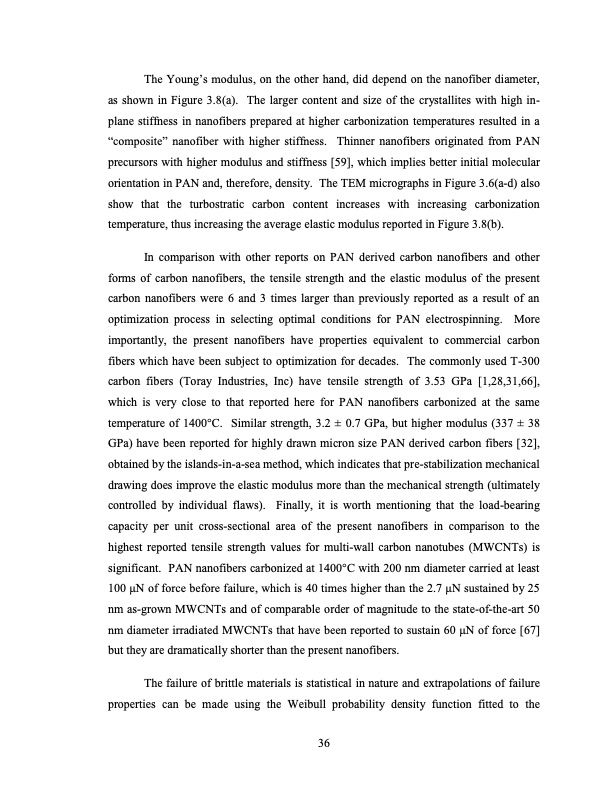
PDF Publication Title:
Text from PDF Page: 043
The Young’s modulus, on the other hand, did depend on the nanofiber diameter, as shown in Figure 3.8(a). The larger content and size of the crystallites with high in- plane stiffness in nanofibers prepared at higher carbonization temperatures resulted in a ―composite‖ nanofiber with higher stiffness. Thinner nanofibers originated from PAN precursors with higher modulus and stiffness [59], which implies better initial molecular orientation in PAN and, therefore, density. The TEM micrographs in Figure 3.6(a-d) also show that the turbostratic carbon content increases with increasing carbonization temperature, thus increasing the average elastic modulus reported in Figure 3.8(b). In comparison with other reports on PAN derived carbon nanofibers and other forms of carbon nanofibers, the tensile strength and the elastic modulus of the present carbon nanofibers were 6 and 3 times larger than previously reported as a result of an optimization process in selecting optimal conditions for PAN electrospinning. More importantly, the present nanofibers have properties equivalent to commercial carbon fibers which have been subject to optimization for decades. The commonly used T-300 carbon fibers (Toray Industries, Inc) have tensile strength of 3.53 GPa [1,28,31,66], which is very close to that reported here for PAN nanofibers carbonized at the same temperature of 1400°C. Similar strength, 3.2 ± 0.7 GPa, but higher modulus (337 ± 38 GPa) have been reported for highly drawn micron size PAN derived carbon fibers [32], obtained by the islands-in-a-sea method, which indicates that pre-stabilization mechanical drawing does improve the elastic modulus more than the mechanical strength (ultimately controlled by individual flaws). Finally, it is worth mentioning that the load-bearing capacity per unit cross-sectional area of the present nanofibers in comparison to the highest reported tensile strength values for multi-wall carbon nanotubes (MWCNTs) is significant. PAN nanofibers carbonized at 1400°C with 200 nm diameter carried at least 100 μN of force before failure, which is 40 times higher than the 2.7 μN sustained by 25 nm as-grown MWCNTs and of comparable order of magnitude to the state-of-the-art 50 nm diameter irradiated MWCNTs that have been reported to sustain 60 μN of force [67] but they are dramatically shorter than the present nanofibers. The failure of brittle materials is statistical in nature and extrapolations of failure properties can be made using the Weibull probability density function fitted to the 36PDF Image | HIGH STRENGTH CARBON NANOFIBERS DERIVED FROM ELECTROSPUN POLYACRYLONITRILE

PDF Search Title:
HIGH STRENGTH CARBON NANOFIBERS DERIVED FROM ELECTROSPUN POLYACRYLONITRILEOriginal File Name Searched:
4835609.pdfDIY PDF Search: Google It | Yahoo | Bing
Sulfur Deposition on Carbon Nanofibers using Supercritical CO2 Sulfur Deposition on Carbon Nanofibers using Supercritical CO2. Gamma sulfur also known as mother of pearl sulfur and nacreous sulfur... More Info
CO2 Organic Rankine Cycle Experimenter Platform The supercritical CO2 phase change system is both a heat pump and organic rankine cycle which can be used for those purposes and as a supercritical extractor for advanced subcritical and supercritical extraction technology. Uses include producing nanoparticles, precious metal CO2 extraction, lithium battery recycling, and other applications... More Info
| CONTACT TEL: 608-238-6001 Email: greg@infinityturbine.com | RSS | AMP |